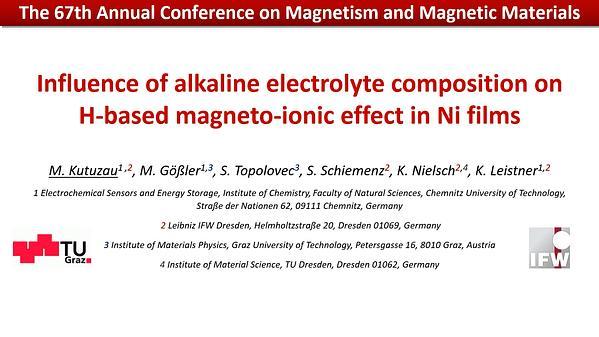Would you like to see your presentation here, made available to a global audience of researchers?
Add your own presentation or have us affordably record your next conference.
Hybrid magnonic-electric computing architectures are promising for ultra-low power data processing 1,2. To realize these computing systems, scalable magnetoelectric
transducers are required that efficiently convert signals between the electric and magnetic domain. Several transducer types have been proposed of which voltage-based concepts are
expected to have the best scaling characteristics 3. A promising voltage-based transducer type consists of a piezoelectric/magnetostrictive bilayer 4. When a voltage is applied to this
transducer, dynamic strain is induced in the bilayer via the piezoelectric effect. This dynamic strain then interacts with the magnetization via the magnetostrictive effect and a coupling
between the electric and magnetic domain is obtained. Although this transducer type is very promising, its fundamental understanding as well as energy efficiency estimates are currently
lacking.
In this work, we develop a theoretical model of the displacement and magnetization dynamics in a resonator consisting of a piezoelectric/magnetostrictive bilayer. The model considers
both elastic as well as magnetic resonances and captures the magnetoelastic effect via an effective stiffness. Via this approach, both the elastic and magnetic power flow inside the device
can be determined. A comprehensive analysis was conducted of the dimensional as well as material parameter influence on the elastic and magnetic power dissipation (see Fig. 1).
Furthermore, the power calculation also results in magnetic transducer efficiency estimates. The results show that magnetic excitation efficiencies up to 90% can be achieved for nanometer
thick magnetostrictive layers (Fig. 2). Finally, a figure of merit is determined which allows to select the optimal piezoelectric-magnetostrictive material combination.
References:
- A. Khitun and K. L. Wang, J. Appl. Phys. 110, 034306 (2011).
- B. Dieny, I. L. Prejbeanu, K. Garello, P. Gambardella, P. Freitas, R. Lehndorff, W. Raberg, U. Ebels, S. O. Demokritov, J. Akerman, et al., Nature Electron, 3 (2020).
- F. Vanderveken, V. Tyberkevych, G. Talmelli, B. Soree, F. Ciubotaru, and C. Adelmann, Sci. Rep. 12, 3796 (2022).
- A. Khitun, D. E. Nikonov, and K. L. Wang, J. Appl. Phys. 106, 123909 (2009).


